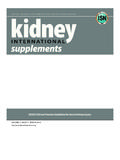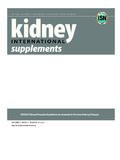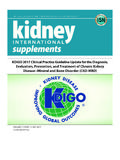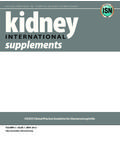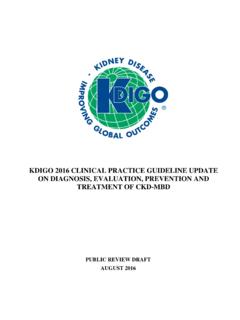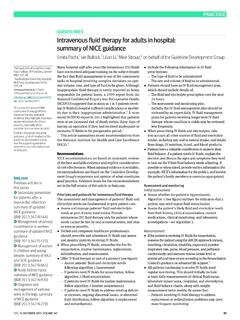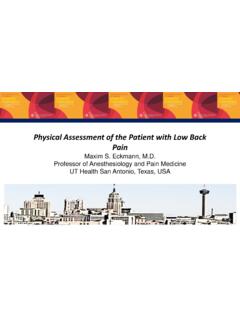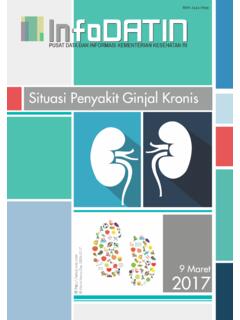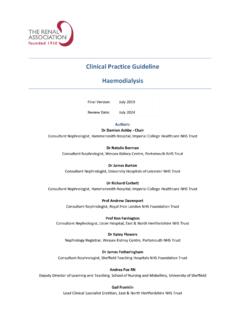Transcription of KDIGO Clinical Practice Guideline for the Evaluation and ...
1 1 Scope of Work KDIGO Clinical Practice Guideline for the Evaluation and Management of Chronic kidney Disease Update 2022 Background This Guideline is an update of the kidney Disease: Improving Global Outcomes ( KDIGO ) 2012 Clinical Practice Guideline for the Evaluation and Management of Chronic kidney Disease (CKD). Despite a further decade of focused research and Clinical Practice in CKD, the global burden of CKD remains high. Whilst underlying causes may vary regionally throughout the world, globally CKD affects nearly 1 in 10 people. CKD has associated disability and high mortality which continue to rise in rank among the leading causes worldwide because of ageing and an increasing burden of risk factors for CKD. Early identification, Evaluation , and management interventions addressed by rigorous data are key tenets of prevention, especially in those regions with the lowest quintiles of Socio-demographic Index where the burden is highest. Who is the Guideline for? The Guideline is intended for healthcare professionals involved in provision of kidney care, people with suspected or diagnosed CKD and their carers, and policy makers and commissioners of CKD services.
2 The aim is to generate a useful resource for the intended audience that clearly and concisely addresses the relevant questions with actionable recommendations and that tackles controversial topics where there is sufficient evidence. Development will follow an explicit process of evidence review and appraisal with recommendations based on systematic reviews of the evidence using the GRADE methodology. Topics with insufficient data will be subject to research recommendations, supplemented by Practice points reached by consensus if required to inform care. Practice points represent the expert judgment of the Guideline Work Group, made where there may be limited evidence, and are therefore ungraded. International considerations will be highlighted in each section to enable directed implementation and advocacy activities where resources are insufficient. In this way, the Guideline document addresses CKD issues around the globe. Implications for Clinical Practice and public policy will also be highlighted where relevant.
3 2 Which groups are included in the scope? Groups that will be covered include adults, children, and young people with suspected or diagnosed CKD not receiving dialysis. Special consideration will be given to those at high risk of progression of CKD and to strategies for their identification to Evaluation and management of CKD in infants (including premature babies), children, and adolescents to very older adults and those with frailty to people with diverse ethnic, geographic, and socio-economic backgrounds to transgender people and those receiving hormone replacement therapy. Evaluation and management interventions and recommendations already covered elsewhere, including acute kidney injury , anemia, CKD-mineral bone disorder (CKD-MBD), diabetes, hypertension, and lipid management, will be alluded to where relevant, but not specifically addressed. Linkages in the final document to specific documents detailing the rationale will be enabled. Which groups are excluded from the scope?
4 Areas outside the scope of this Guideline update include management of specific causes of CKD such as glomerulonephritis, pregnancy in women with CKD, cancer, kidney replacement therapy, and end of life care. Each of these topics warrants more fulsome discussion and attention than could be appropriately developed within this document. Outcomes of interest will include: mortality (all cause and cardiovascular) progression of CKD complications of CKD including but not limited to cardiovascular disease, anemia, CKD-MBD, infection (including Covid-19), acute kidney disease, frailty health-related quality of life patient reported outcome measures (PROMs) health care utilization (in-patient and outpatient utilization) variability of outcome by cause of CKD unintended adverse incidents. Key questions to be addressed continue to be the Evaluation of kidney functions including indicators of tubular function, and of progression of kidney disease and how both Evaluation and progression may be influenced and affected by age, sex, ethnicity, inheritance, environmental factors, and underlying cause.
5 Other areas for consideration in the Evaluation and management of CKD include genome typing, point of care testing, digital innovations, novel treatments, Covid-19, acute kidney disease, and the special populations already detailed. 3 Chapter Outline and Rationale for Topic Selection *Denotes topic for systematic evidence review 1. CKD Disease Definition and Classification CKD is defined as abnormalities of kidney structure or function, present for >3 months, with implications for health and CKD is classified based on cause, GFR category, and albuminuria category (CGA). This section will integrate new information and examine the value (and relative limitations) of CKD definition and classification. Glomerular filtration rate measurement and estimation Measured GFR methodology, variability and the influence of body surface area calculation* Which marker? Urinary clearance of inulin is the traditional gold standard but pragmatism leads to use of urinary or plasma clearance methods using other exogenous markers, but which markers (EDTA, DTPA, iohexol, iothalamate) have been demonstrated to give acceptably equivalent results to inulin clearance.
6 What are the international considerations? What sampling methodology and which body surface area normalization should be recommended? Serum creatinine and cystatin C-based estimating equations (all ages)*, Other biomarkers for eGFR* A review of GFR estimating equations addressing accuracy, generalizability and applicability and the role of cystatin C and other biomarkers used to estimate GFR. Practical versus theoretical considerations. Age, race, and sex considerations The influence of age, race, and sex on GFR. Also addressing the concepts of age, race, and sex as modifiers of definition versus modifiers of treatment approaches and prognosis. Reviewing the value of the emphasis on prognosis to avoid unintended harm in the frail elderly population caused by generalizing 4 outcomes from evidence derived from healthy volunteers in similar CKD categories. Recommendations by several national and international organizations to remove race from existing estimating equations will be highlighted and the rationale explained including the complexity of the impact of race on health outcomes in general and kidney outcomes specifically.
7 Functional reserve* Under certain circumstances GFR alone may not be as important as an assessment of GFR reserve (stimulated GFR minus basal GFR), which may be of particular importance to the AKD-AKI-CKD continuum, and the assessment of kidney donors with normal kidney function. What tests do we have to measure and define this? How applicable and reproducible are they? What would be the value of testing in Clinical Practice , , under what circumstances would the testing be recommended, if reproducible? What about tubular function and tubular stress tests to delineate functional reserve? Albuminuria and proteinuria measurements* What is the evidence comparing urinary albumin:creatinine ratio (ACR) with protein:creatinine ratio (PCR) in infants, children and young adults? When is reagent strip assessment not applicable and when should alternative proteinuria assessments to urinary ACR be recommended (all ages)? Tests of tubular function and damage* GFR and albuminuria are well-recognized parameters by which CKD is diagnosed, and also serve the basis for the classification system.
8 However, a variety of kidney diseases may be marked by abnormalities associated with tubular function, most commonly potassium or bicarbonate. How might we incorporate this into current diagnostic criteria? What are the data that would guide diagnostic and prognostic recommendations based on potassium or bicarbonate abnormalities in association with GFR and/or urine protein measurements, or independent of them? 5 Point of care testing* What is the value and utility of point of care testing (hemoglobin, sodium, potassium, bicarbonate, creatinine in blood and saliva)? What tools are reliable, and in what circumstances would we advocate for point of care testing for kidney disease? What additional studies are required to assess utility in which Clinical circumstances? Role of kidney biopsy Percutaneous kidney biopsy may be undertaken for a variety of reasons, including diagnosis of cause, planning and monitoring treatment, determining prognosis and assessing genetic disease.
9 However, the indications frequently vary by nephrologist so what does the evidence drive us to recommend? What is the true risk of kidney biopsy (assessment of risk:benefit in specific diseases)? Role of genome typing Genome typing may improve diagnosis, inform disease surveillance and Clinical management and guide family counselling. Monogenic kidney disease has a direct genotype to phenotype relationship and over 600 pathogenic variants in single genes have been described. These are rare but certain common genetic variants or polygenic risk scores may also be appropriate for Clinical reporting where they can be shown to add value in diagnosis, treatment, and surveillance. Screening for CKD Is there a role for targeted early detection/risk stratification/screening? A number of organizations support CKD screening in specific at-risk groups, such as those with hypertension, diabetes, older age, family history of kidney disease, and in racial groups known to be at increased risk from kidney disease.
10 CKD is frequently asymptomatic in its early stages, constitutes a severe burden for patients and a significant cost burden for healthcare systems worldwide. Is there sufficient evidence to widen current recommendations? 6 2. Prediction of CKD Progression What is the value of prediction of CKD progression and the need for prediction under differing circumstances: Clinical care decisions versus entry into trials and trial follow up and monitoring? Encompassing: the utility of individualizing risk assessment the use of cystatin C as a predictor of outcome and that of other biomarkers of progression the frequency of monitoring and what governs this in different populations the impact of, and interaction between, different kidney disease phenotypes genome typing review of the relationship between AKD and incident CKD, and AKD and progression of CKD This section will differentiate prediction of individual progression versus that of populations and differentiate prediction for the different types of Clinical decisions, also considering referral versus initiation of therapy versus transition.

